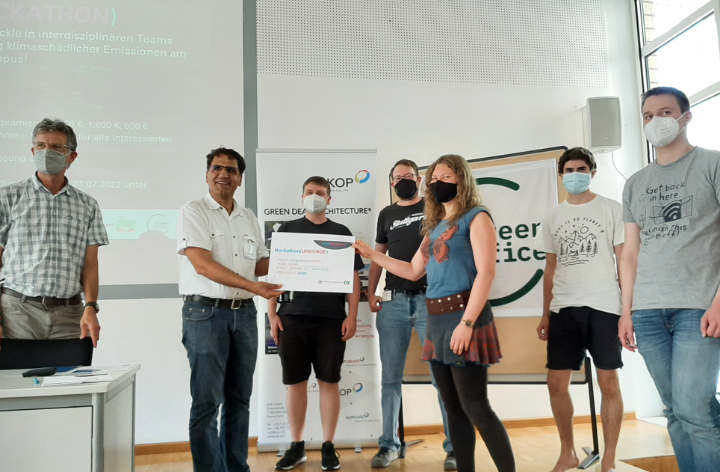
At the klima(HACKATHON), in just 24 hours around 40 employees and students at the University of Stuttgart came up with creative solutions to improve climate protection on the Vaihingen campus, or to promote climate protection measures at the University of Stuttgart. University members were invited to attend by the event organizers: the Real-World Laboratory CampUS hoch i, the Informatik-Verbund Stuttgart (IVS) and the University of Stuttgart's Green Office.
In his welcoming speech, the chairman of the IVS and head of the Institute of Industrial Automation and Software Engineering (IAS), Professor Michael Weyrich, highlighted how important it is for the University of Stuttgart, as a high-performance and technology-oriented university, to focus on developing solutions for climate protection. Weyrich emphasized, "Digital solutions will make a significant contribution to this.” Professor Kai Hufendiek, project leader of CampUS hoch i and head of the Institute of Energy Economics and Rational Energy Use (IER), emphasized that a collaborative approach that unites all the major groups at the university is paramount in ensuring effective climate protection. "We were very grateful for the alliance with the IVS and the Green Office at the hackathon, and for the companies who support our project CampUS hoch I and the klima(HACKATHON), for example by providing the prize money."
Everyone participating in the klima(HACKATHON) developed concepts, applications and design proposals within the given time. Participants were then required to present their ideas to the audience and the jury in a five-minute pitch on the final day. After numerous group discussions, and a few sleepless hours, the teams also mastered the short project presentation brilliantly. The project coordinator for the event, Dr. Ludger Eltrop, is very satisfied with the results: "We will continue to work with the teams. The solutions they came up with deserve to be pursued further, and we would like to make this possible."
The hackathon's award-winning ideas
The jury and audience struggled to determine the sequence of prize-winners following the completion of the pitches and project presentations, because so many excellent ideas had been presented. The first two prizes were awarded to:
- The project "SaNuCo" (Salad, Pasta & Co.), which quickly developed a practical prototype for a food-sharing app that was also dedicated to social aspects, namely a "culture of sharing".
- The "BEe on CampUS" project, which made excellent use of a very impressive concept for visualizing emissions on campus, where a bee playing a leading role as a motivator.
The audience award went to the project "CampUS Aquarium". This idea focused on the visualization of emissions on campus, where the rising sea level is transferred to the campus and, in the event of poor climate protection, the Vaihingen campus virtually "sinks into the sea".
The other project ideas were also very creative and exciting:
- The NISARGA project presented an application programmed in Python in which the university's buildings can be equipped with sensors at very low cost, thus reducing energy consumption.
- The project "reSOURCE" presented a platform where resources can be shared and exchanged by using unused or little used equipment (tools, machines, EDP) at the university.
- In the project "climatik moves", a concept was developed for sharing or recycling uneaten food from the university canteen and at home.
- In its conception for an app, the "PV-UP" project focused entirely on the topic of "integration" and how the data from photovoltaic systems can be transferred to an energy portal.
- The "fahrmitUnS" project aims to facilitate the formation of "ad hoc" carpools and relies on an app with an integrated calendar and equipping the algorithm with artificial intelligence.
- In the "Food is Energy" project, the team aims to use social media to promote the possibilities of reducing food waste and using it more wisely.
Creative solutions developed in 24 hours
A total of nine groups participated in the klima(Hackathon). All six proposed topic areas were covered by at least one group. The topics were:
- Determination of a person's individual ecological footprint
- Intelligent building operation
- Increasing local potential for photovoltaics
- Visualization of polluting emissions
- Sharing devices and facilities
- Sharing food to reduce emissions
It was intended that the subject areas should be approached primarily with a local connection to the Vaihingen campus. Digital applications such as apps, but also concepts or design proposals were developed. Programming knowledge was not necessarily required to participate. An enjoyment of practical solutions and teamwork was just as important. Dr. Nasser Jazdi, Managing Director of IVS was enthusiastic about the variety and quality of the ideas: "We should do this more often. We will definitely consider offering the hackathon again next year." He expressed his conviction that both the format and focus of the event will continue to receive an enthusiastic response and that students and employees at the University of Stuttgart will be happy to participate.
The projects presented not only have the potential to reduce climate-damaging emissions on campus, they also make a valuable contribution to the sustainability strategy and long-term sustainable development at the University of Stuttgart.
This event was supported by the Baden-Wuerttemberg Ministry of Science, Research and Art.
| Contact | Dr. Ludger Eltrop, Institute of Energy Economics and Rational Energy Use, University of Stuttgart, E-Mail, Telefon +49 711 685-87816 |
|---|


